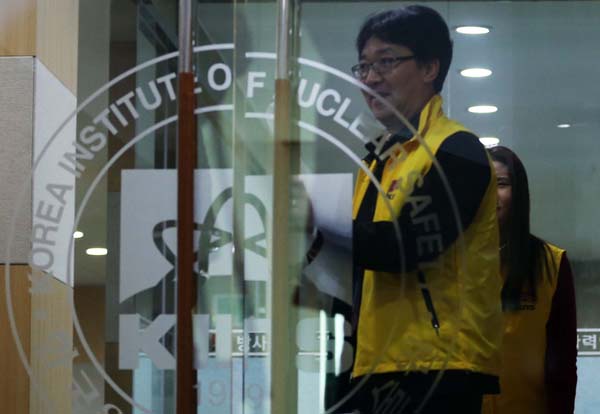North’s tunnel design keeps leakage contained

Officials from the Korea Institute of Nuclear Safety walk out of the lab on Thursday to announce they could not detect traces of xenon from air samples they collected over the East Sea. [YONHAP]
After conducting its first nuclear test in 2006, North Korea changed the internal structure of its underground site in Punggye-ri in North Hamgyong Province so that it does not allow any radioactive leakage for other countries to analyze, an official from Seoul’s Ministry of Defense said yesterday.

“We’re assuming that after that, [the North] changed the structure of its underground tunnel from a linear shape to a fishhook shape and also has installed several bulkheads, which is why we’ve been unable to detect any gas leakage.”
A week has passed since Pyongyang conducted its third nuclear test, and there has been no detection of radioactive nuclear gas from air samples.
An official from the Korea Institute of Nuclear Safety said, “We have completed analyzing 23 air samples collected from the air, ground and sea, but we weren’t able to detect any traces of radioactive nuclear material such as xenon or krypton.”
Both South Korea and the United States have made efforts to collect radioactive nuclides by bottling up air using special reconnaissance aircraft such as the RC-135W and KA-1.
The Korea Institute of Nuclear Safety and the Korea Atomic Energy Research Institute have also used operational devices on the ground and sea to collect nuclides but reportedly failed.
“After the nuclear test, the wind has been blowing toward Japan,” Defense Minister Kim Kwan-jin told the JoongAng Ilbo yesterday.
“Collecting [nuclear] materials in Korea has become practically difficult now, and we will have to hope that equipment in Japan is able to collect it.”
Even when the North conducted its second nuclear test in 2009, South Korea failed to detect any leaked gases.
According to observers, countries like South Korea and the U.S. have focused on collecting nuclear material because it is the smoking gun that helps determine what type of nuclear test the North conducted and how strong it was.
The official from the Defense Ministry said that North Korea has closed down the tunnel on the east side of the site for the recent test.
The tunnel was used for conducting the first test in 2006.
“North Korea has abundant graphite reserves,” the official said.
“We are assuming that the North used massive amounts of graphite that are known to be efficient in absorbing radiation when constructing the tunnel to minimize leakage.”
In 2006, when the observatory station in Canada detected radiation after the North’s first test, the official said that there was intelligence that the North’s then leader Kim Jong-il made a remark that the regime “should come up with a thorough measure [so that there is no leakage of radiation] because if it does leak into areas nearby, including China, it can become a problem.”
By Jeong Yong-soo [angie@joongang.co.kr]










with the Korea JoongAng Daily
To write comments, please log in to one of the accounts.
Standards Board Policy (0/250자)